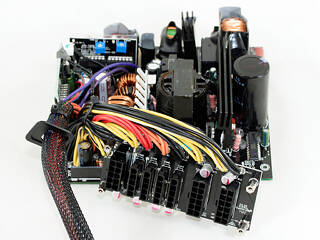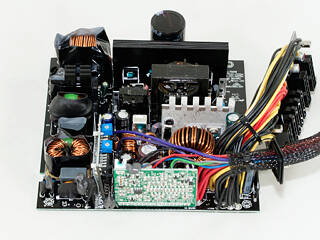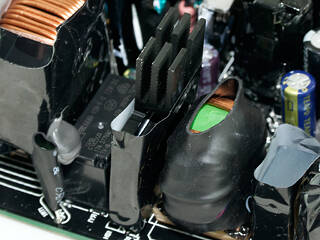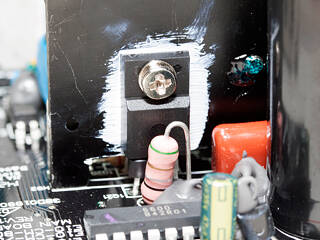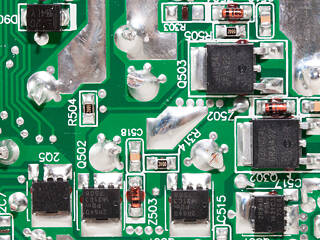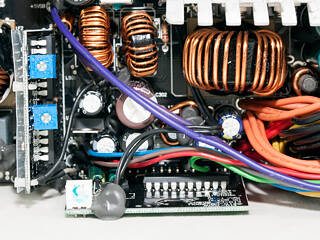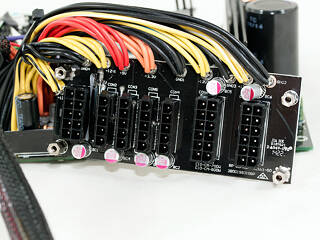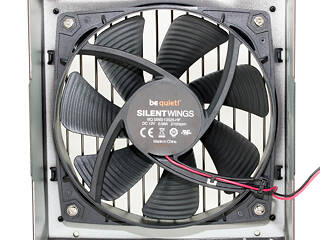 5
5
be quiet! Straight Power 10 CM 800 W Review
Load Regulation, Hold-up Time & Inrush Current »A Look Inside & Component Analysis
Before reading this page, we strongly suggest a look at this article, which will help you understand the internal components of a PSU much better. Our main tool for the disassembly of the PSU is a Thermaltronics TMT-9000S soldering and rework station. It is of extreme quality and is equipped with a matching de-soldering gun. With such equipment in hand, breaking apart every PSU is like a walk in the park!| be quiet! E-10-CM 800W Parts Description | |
|---|---|
| Primary Side | |
| Transient Filter | 4x Y caps, 2x X caps, 1x CM chokes, 1x MOV |
| Bridge Rectifier(s) | 1x unknown |
| Inrush Current Protection | NTC Thermistor & Relay |
| APFC Mosfets | 2x IPA60R160C6 |
| APFC Boost Diode | 1x STTH8R06FP |
| Hold-up Cap(s) | 1x Teapo (420V, 390uF, 105°C, LG) |
| Main/Reset Switchers | Main switchers: 2x Infineon SPA11N80C3 Reset Mosfet: 1x Fairchild FQPF3N80C |
| APFC / Switching Controller | FSP 6600 IC |
| Topology | Active Clamp Reset Forward (ACRF) |
| Secondary Side | |
| +12V | 4x Infineon Mosfets |
| 5V & 3.3V | DC-DC Converters: 4x PBm2R640 fets, 2x Infineon IPD036N04L PWM Controller: 2x FSP6601 |
| Filtering Capacitors | Electrolytics: Teapo (105°C) Polymers: Teapo |
| Supervisor IC | Weltrend WT7579 |
| Fan Model | Silent Wings BQSIW3-13525-HF (12 V, 0.56 A, 2100 RPM, Fluid Dynamic Bearing) |
| 5VSB Circuit | |
| Filtering Capacitor | Nippon Chemi-Con (10V, 4700 uF, 105°C, KZH) |
FSP manufactures this unit, and like most of their Gold-certified platforms, this one utilizes an Active Clamp Reset Forward (ACRF) topology for high efficiency and good power handling capability. In the ACRF, two mosfets are used. One plays the role of the main switcher (Q1), while the other is the reset switch (Q2) that disconnects the main capacitor while Q1 is active. Power is also only transferred from the primary to the secondary side while Q2 is open. The main advantage of ACRF is the almost lossless switching of Q1 since the drain voltage is very low while it is turned off, which results in higher efficiency. Higher capacity PSUs like this one can use two Q1 fets instead of one; however, there is no need for a second reset fet. In the secondary side, synchronous rectification is used, which results in lower energy losses than with passive rectification models.
The PCB is densely populated and both heatsinks, especially the heatsink in the secondary side, are small. However, this PSU at least uses an actual heatsink in its secondary side, and we have lately actually come across several platforms (mostly from CWT) that don't have an actual heatsink in their secondary side. The Straight Power line belongs to the mid-level category, so be quiet! tried to keep costs low by using Taiwanese Teapo instead of more expensive Japanese caps.
The transient filter starts with a pair of Y caps right at the AC receptacle and continues with a single CM choke, two X and two Y caps, and an MOV on the main PCB.
Under one of these X caps is a CM02X. This IC increases efficiency by blocking the current that passes through the cap's discharge resistor when AC voltage is connected.
There is an NTC thermistor to protect the PSU from large inrush currents, and a corresponding relay that isolates the thermistor from the circuit once it finishes its job.
The single bridge rectifier, surrounded by black tape, is bolted to a dedicated heatsink.
The APFC converter's circuit uses two IPA60R160C6 fets and a single STTH8R06FP boost diode. The single bulk cap is provided by Teapo (420 V, 390 µF capacity, 105°C).
Two main switchers are used in this PSU (Q1 and Q2), while the third is the reset switch (Q3). Two SPA11N80C3s act as respective Q1 and Q2 switches, while an FQPF3N80C is the Q3 reset switch. An FSP 6600 IC for which there is no documentation available on the net is the APFC/PWM controller.
A synchronous design is used in the secondary side, and four mosfets, which we unfortunately couldn't identify because their markings had been erased, regulate the +12V rail. Two DC-DC converters on the solder side of the main PCB deliver the minor rails. In total, six mosfets (4x PBm2R640 and 2x Infineon IPD036N04L) and two FSP6601 controllers are used by these converters.
All filtering caps in the secondary side except for a single Chemi-Con cap for the 5VSB circuit are by Teapo. FSP tends to use high quality caps for the %VSB circuit since it is constantly operating, even while the PSU is turned off but the on/off switch is in the on position.
A daughter-board in the secondary side hosts the supervisor IC, a Weltrend WT7579.
FSP installed several polymer Taepo caps for some additional ripple filtering onto the front the modular board.
Soldering quality on the main PCB is pretty good. We spotted four current shunt resistors under the +12V islands. These are used by the unit's OCP (Over Current Protection) circuit.
The high quality SilentWings fan be quiet! chose for this unit uses a Fluid Dynamic Bearing, and due to be quiet!'s relaxed fan profile, it produces very little noise with even a high load. Its model number is BQ SIW3-13525-HF (12 V, 0.56 A, 2100 RPM).
Mar 29th, 2025 11:19 EDT
change timezone
Latest GPU Drivers
New Forum Posts
- Small chip on the tempered glass (13)
- The TPU UK Clubhouse (25998)
- Upgrade from a AMD AM3+ to AM4 or AM5 chipset MB running W10? (30)
- Which thermal paste never pumps out? (70)
- EVGA 3070ti hotspot is too high 107.7° (5)
- Your PC ATM (35295)
- Did Nvidia purposely gimp the performance of 50xx series cards with drivers (118)
- What are you playing? (23308)
- Should you physically remove secondary NVMe drives when performing a clean Windows install? (42)
- PCI 4.0 16x slot reported as a PCI 5.0 8x with the AMD 9070 XT Reaper GPU (37)
Popular Reviews
- Sapphire Radeon RX 9070 XT Pulse Review
- Samsung 9100 Pro 2 TB Review - The Best Gen 5 SSD
- ASRock Phantom Gaming B850 Riptide Wi-Fi Review - Amazing Price/Performance
- Assassin's Creed Shadows Performance Benchmark Review - 30 GPUs Compared
- be quiet! Pure Rock Pro 3 Black Review
- Sapphire Radeon RX 9070 XT Nitro+ Review - Beating NVIDIA
- ASRock Radeon RX 9070 XT Taichi OC Review - Excellent Cooling
- Palit GeForce RTX 5070 GamingPro OC Review
- Pulsar Feinmann F01 Review
- AMD Ryzen 7 9800X3D Review - The Best Gaming Processor
Controversial News Posts
- MSI Doesn't Plan Radeon RX 9000 Series GPUs, Skips AMD RDNA 4 Generation Entirely (142)
- Microsoft Introduces Copilot for Gaming (124)
- AMD Radeon RX 9070 XT Reportedly Outperforms RTX 5080 Through Undervolting (118)
- NVIDIA Reportedly Prepares GeForce RTX 5060 and RTX 5060 Ti Unveil Tomorrow (115)
- Over 200,000 Sold Radeon RX 9070 and RX 9070 XT GPUs? AMD Says No Number was Given (100)
- NVIDIA GeForce RTX 5050, RTX 5060, and RTX 5060 Ti Specifications Leak (96)
- Retailers Anticipate Increased Radeon RX 9070 Series Prices, After Initial Shipments of "MSRP" Models (90)
- China Develops Domestic EUV Tool, ASML Monopoly in Trouble (88)


